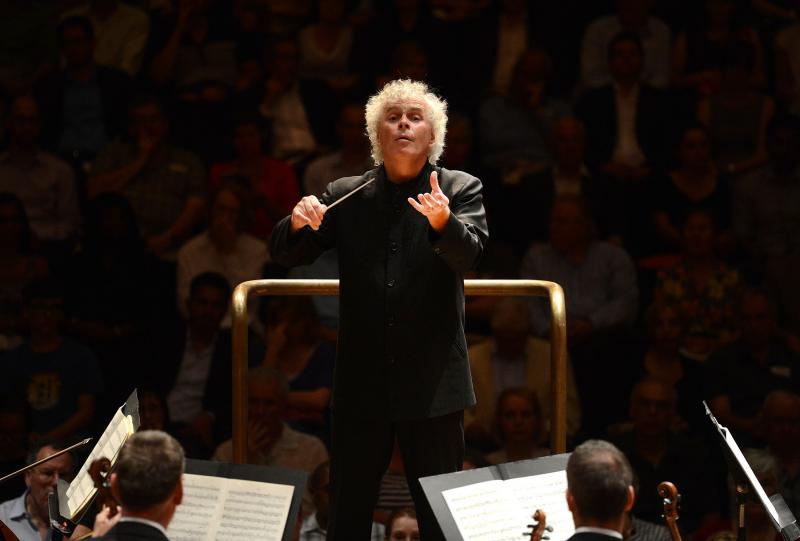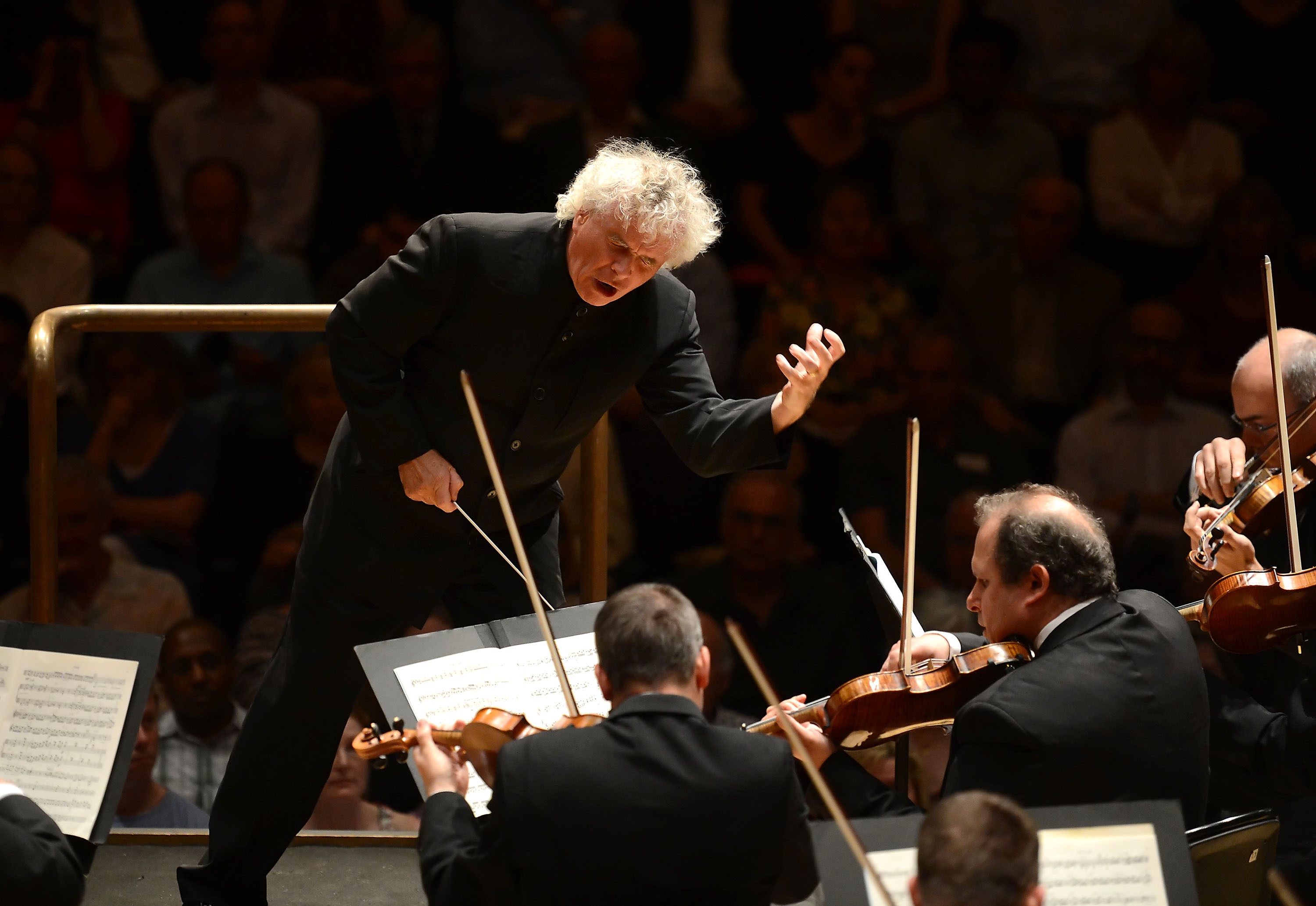Bruckner 8, LSO, Rattle, Barbican | reviews, news & interviews
Bruckner 8, LSO, Rattle, Barbican
Bruckner 8, LSO, Rattle, Barbican
Fresh perspectives on a symphonic monolith

Last and most imposing of Bruckner’s completed symphonies, the Eighth invites and frequently receives architectural comparisons.
Over a span of 80-plus minutes, Bruckner transforms a double-dotted, death-watch tattoo in C minor into unanswerably emphatic C major. As ever, the destination is less important than the journey. The tempi were flexible, so that one episode eased into the next and although the pulse often changed, the harmonic undertow remained strong and steady. So did the narrative coherence of a piece which is often heard in terms of imposing but essentially static blocks placed beside one another for contrast more than continuity. Such a view was elegantly demolished. Rattle pressed on, even at the apotheosis of the Adagio, finding connections and grasping Ariadne’s thread in this symphonic labyrinth so that when the death-watch returned before the finale’s coda, its meaning and its redemption were plain to hear.
 The sound of the LSO was shaped by a proprietary orchestral layout deriving from Rattle’s long experience with the philharmonic orchestras of Berlin and Vienna. Divided violins made much of the finale’s contrapuntal interplay. Given their place in the sun directly in front of Rattle, violas warmed the teeming inner life of the Scherzo. Brass and timpani were carefully placed at opposite ends of the platform like the naughtiest boys in the classroom. The unconscious temptation to compete and dominate was thus avoided. The harvest of these orchestral manoeuvres, Bruckner Untangled.
The sound of the LSO was shaped by a proprietary orchestral layout deriving from Rattle’s long experience with the philharmonic orchestras of Berlin and Vienna. Divided violins made much of the finale’s contrapuntal interplay. Given their place in the sun directly in front of Rattle, violas warmed the teeming inner life of the Scherzo. Brass and timpani were carefully placed at opposite ends of the platform like the naughtiest boys in the classroom. The unconscious temptation to compete and dominate was thus avoided. The harvest of these orchestral manoeuvres, Bruckner Untangled.
Evidently rehearsed and run in after concerts in Luxembourg and Paris, there was much truly quiet playing to treasure – the first movement expired like a guttering flame – but more pertinently the distinction between forte and fortissimo always meant something. Never once blasting or blaring, this was a Bruckner performance for the unconverted. The execution was by no means faultless, particularly in the finale, but Rattle seemed to get what he wanted, and he knows how to get everyone to listen, both before and behind him; the audience was a twelfth man.
Before the interval, Pierre-Laurent Aimard was the unfussily stylish soloist in Couleurs de la cité celeste. Messiaen and Bruckner make good concert companions, not only as the most devotional of Catholic composers in the canon but in terms of formal and timbral contrasts: I have happy memories of Rattle’s pairing at the BBC Proms, many years ago, of the Seventh with Chronochromie (1960). Overlooked and underappreciated, Couleurs dates from three years later, still within Messiaen’s boldest and most innovative period. Determinedly non-developmental, it nonetheless encloses a processional of rainbow-dressed pilgrims on their way to the title’s heavenly city. Beautifully voiced brass chorales were punctuated here by coruscating solos from Aimard and incisive contributions from a trio of clarinets and a happy family of tam-tams. These joyous discontinuities made it all the easier to appreciate the Bruckner as a seamless garment.
rating
Share this article
The future of Arts Journalism
You can stop theartsdesk.com closing!
We urgently need financing to survive. Our fundraising drive has thus far raised £49,000 but we need to reach £100,000 or we will be forced to close. Please contribute here: https://gofund.me/c3f6033d
And if you can forward this information to anyone who might assist, we’d be grateful.

Subscribe to theartsdesk.com
Thank you for continuing to read our work on theartsdesk.com. For unlimited access to every article in its entirety, including our archive of more than 15,000 pieces, we're asking for £5 per month or £40 per year. We feel it's a very good deal, and hope you do too.
To take a subscription now simply click here.
And if you're looking for that extra gift for a friend or family member, why not treat them to a theartsdesk.com gift subscription?
more Classical music
 Robin Holloway: Music's Odyssey review - lessons in composition
Broad and idiosyncratic survey of classical music is insightful but slightly indigestible
Robin Holloway: Music's Odyssey review - lessons in composition
Broad and idiosyncratic survey of classical music is insightful but slightly indigestible
 Classical CDs: Wolf-pelts, clowns and social realism
British ballet scores, 19th century cello works and contemporary piano etudes
Classical CDs: Wolf-pelts, clowns and social realism
British ballet scores, 19th century cello works and contemporary piano etudes
 Bizet in 150th anniversary year: rich and rare French offerings from Palazzetto Bru Zane
Specialists in French romantic music unveil a treasure trove both live and on disc
Bizet in 150th anniversary year: rich and rare French offerings from Palazzetto Bru Zane
Specialists in French romantic music unveil a treasure trove both live and on disc
 Scottish Chamber Orchestra, Ibragimova, Queen’s Hall, Edinburgh review - rarities, novelties and drumrolls
A pity the SCO didn't pick a better showcase for a shining guest artist
Scottish Chamber Orchestra, Ibragimova, Queen’s Hall, Edinburgh review - rarities, novelties and drumrolls
A pity the SCO didn't pick a better showcase for a shining guest artist
 Kilsby, Parkes, Sinfonia of London, Wilson, Barbican review - string things zing and sing in expert hands
British masterpieces for strings plus other-worldly tenor and horn - and a muscular rarity
Kilsby, Parkes, Sinfonia of London, Wilson, Barbican review - string things zing and sing in expert hands
British masterpieces for strings plus other-worldly tenor and horn - and a muscular rarity
 From Historical to Hip-Hop, Classically Black Music Festival, Kings Place review - a cluster of impressive stars for the future
From quasi-Mozartian elegance to the gritty humour of a kitchen inspection
From Historical to Hip-Hop, Classically Black Music Festival, Kings Place review - a cluster of impressive stars for the future
From quasi-Mozartian elegance to the gritty humour of a kitchen inspection
 Shibe, LSO, Adès, Barbican review - gaudy and glorious new music alongside serene Sibelius
Adès’s passion makes persuasive case for the music he loves, both new and old
Shibe, LSO, Adès, Barbican review - gaudy and glorious new music alongside serene Sibelius
Adès’s passion makes persuasive case for the music he loves, both new and old
 Anja Mittermüller, Richard Fu, Wigmore Hall review - a glorious hall debut
The Austrian mezzo shines - at the age of 22
Anja Mittermüller, Richard Fu, Wigmore Hall review - a glorious hall debut
The Austrian mezzo shines - at the age of 22
 First Person: clarinettist Oliver Pashley on the new horizons of The Hermes Experiment's latest album
Compositions by members of this unusual quartet feature for the first time
First Person: clarinettist Oliver Pashley on the new horizons of The Hermes Experiment's latest album
Compositions by members of this unusual quartet feature for the first time
 Gesualdo Passione, Les Arts Florissants, Amala Dior Company, Barbican review - inspired collaboration excavates the music's humanity
At times it was like watching an anarchic religious procession
Gesualdo Passione, Les Arts Florissants, Amala Dior Company, Barbican review - inspired collaboration excavates the music's humanity
At times it was like watching an anarchic religious procession
 Classical CDs: Camels, concrete and cabaret
An influential American composer's 90th birthday box, plus British piano concertos and a father-and-son duo
Classical CDs: Camels, concrete and cabaret
An influential American composer's 90th birthday box, plus British piano concertos and a father-and-son duo
 Cockerham, Manchester Camerata, Sheen, Martin Harris Centre, Manchester review - re-enacting the dawn of modernism
Two UK premieres added to three miniatures from a seminal event of January 1914
Cockerham, Manchester Camerata, Sheen, Martin Harris Centre, Manchester review - re-enacting the dawn of modernism
Two UK premieres added to three miniatures from a seminal event of January 1914

Add comment